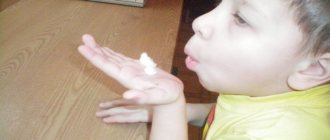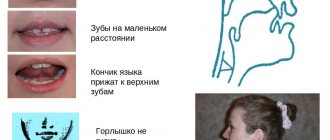One of the problems in the development of a child’s speech is the production of the sound L. Many exercises have been developed to develop correct pronunciation. It is better to perform them under the supervision of a speech therapist. Once the pronunciation skill has been developed, it needs to be automated. Training can take a long time.
To make the sound “L”.
What is lambdacism and its varieties
Lambdaism is usually called the incorrect pronunciation of the sound L or its complete loss in speech.
There are several types of this violation:
- Nasal - when you exhale, the air flows through the nose. The reason for this pronunciation is that the soft palate is in contact with the root of the tongue. Instead of "lamp" it becomes "ngampa".
- Bilabial - when pronouncing, the labial muscles tense; instead of the desired sound, the child pronounces “u” - “uapata” instead of the word “shovel”.
- Interdental - the tip of the tongue falls out between the teeth.
- Lower - the tongue rests on the lower teeth. This variety is the most difficult to correct.
- Fricative - instead of the desired sound, a softened (“Ukrainian”) G is obtained.
Replacing the sound L with others is called paralambdacism.
The most common types of replacement:
- B - “vuk” instead of “bow”;
- D - “dozhka” instead of spoon;
- Y - “yampa” instead of “lamp”;
- soft L - “plait” instead of “raft”.
Some children experience a complete loss of the L sound. Instead of the word “fox,” they pronounce “isa.”
Hard "l"
If a child can pronounce a soft “l”, then a hard one is a little more difficult for him due to the fact that the position of the tongue requires him to occupy the upper position. Usually in such cases there is no sound at all or is replaced by others.
To raise the tongue up, there are several exercises that also strengthen the muscles of the tongue.
- "The tongue is sleeping." The tongue is motionless between the teeth. The child is given the task of repeating “a” protractedly and continuously; after a little time, the baby is given the task of periodically biting the tip of the tongue, which results in “al.”
- Another exercise for a hard “l” is to sing “y”, but already biting your wide tongue. After this, we ask you to pronounce words with different placements of “l” in the words. The sound “l” at the beginning of a word: puddle, ski, fly, flying, burst, laser, bark, light bulb, lion, fox, pour, burst. In the middle of the word: class, eyes, analysis. At the end of the word: table, glass.
The next stage is the pronunciation of rhymes and tongue twisters, where the hard “l” is often found.
What are the reasons for the incorrect pronunciation of L?
Until the age of 4, the speech apparatus is not adapted to pronouncing this sound, so lambdaism at this age is considered a variant of the norm.
There are several reasons why a child speaks incorrectly:
- Improper breathing during speech.
- Disturbances in the development of speech hearing - the child has difficulty hearing the speech of other people and does not perceive meaning well.
- Insufficient development of the articulatory apparatus, weakness of facial muscles and tongue. These muscles play a leading role in the pronunciation of sounds.
- Deviations in the structure of the hyoid ligament (frenulum) - speech disorders are possible if the ligament is short.
Improper breathing can be due to several factors:
- The child's lung capacity is reduced.
- The respiratory muscles are weak, so the child cannot speak loudly.
- When exhaling, the air stream comes out in jerks, so it becomes difficult to finish a long sentence.
- Incorrect distribution of air, resulting in inhalation starting in the middle of the word.
Formation of correct pronunciation of sounds
If the child does not suffer from diseases or pathological developments of the speech apparatus, then adults can quickly solve the problem. To understand how to make the “l” sound at home, you should follow a few simple rules.
- Work should begin with strengthening articulatory motor skills. Its strengthening is achieved through exercises and games.
- The next stage is sound production. The methods are different. There is a method for each case.
- The production of sound flows into pronunciation. When the student has learned to pronounce the letter, he must move on to syllables, and then to simple words and sentences with many repeating sounds.
- Let's move on to more labor-intensive work. We learn rhymes and tongue twisters. A preschooler will learn sounds faster and develop memory.
- Results should be consolidated through telling and repeating fairy tales, short stories, poems, stories, and singing songs.
These simple rules should be given very little time a day. It is easier to transform a unique curriculum into a game. The process won't be boring. You and your child will be passionate about business, not tedious work.
How to position your tongue and lips
Articulation of the sound "L".
In most children, lambdaism is associated not with anatomical disorders of the speech apparatus, but with incorrect positioning of the lips and tongue.
To achieve correct pronunciation, you must follow these rules:
- Make sure that the upper teeth do not touch the lower teeth. There should be a narrow space between them.
- The sides of the tongue should not touch the upper molars. This will ensure proper breathing.
- The tip should be firm and rest on or just above your upper teeth.
- The area at the root should be slightly raised.
- The upper palate is slightly raised so that air cannot enter the nasal cavity when exhaling.
- The vocal cords vibrate and create the vocal sound.
The position of children's lips depends on what sound follows L.
What mistakes can there be when trying to pronounce L?
If a child tries to pronounce the sound L, the following errors are possible:
- The tongue goes deep into the oral cavity, its tip does not come into contact with the upper teeth or gums. Instead of the desired sound, the child produces Y (“boat” - “yodka”).
- A sharp breath at the moment when you need to say the right sound. If the muscles of the cheeks are involved in the process, the phoneme F is obtained.
- The air flow passes into the nose, so it turns out to be N.
Sometimes the child is first given R and then L. In such a situation, the second sound can replace the first (“rune” instead of “moon”)
Setting the “l” for a preschooler
Preschool age is an important period for everyone. Until this moment, babies learn to walk, talk, understand the world around them and themselves. Some consonants are difficult to pronounce and develop over time. It’s worse when parents don’t pay attention to their child’s speech defects. In adulthood, it is already very difficult to eliminate them, which is why speech therapists work with children in groups and individually in all kindergartens.
The most common consonants that are difficult to pronounce are “l” and “r”. Of course, as you grow older, problems may go away without outside help, and sometimes they don’t. The job of speech therapists is to help the preschooler develop correct pronunciation. The sound “l” can be both soft and hard. Sometimes a baby cannot pronounce one type, but more often children have problems pronouncing “l” in both cases.
Preparing for the exercises
Before starting the training, the child is shown how L should sound correctly. Several words are pronounced with clear articulation. The child should see how the lips and tongue are positioned. They name several words that contain this letter, and ask them to determine by ear which part of the word it is in.
To form the correct passage of air, do breathing exercises.
Mistakes a child makes.
Then the child is asked to perform preparatory exercises:
- "Hammock". The tip of the tongue rests on the upper front teeth. Curl your tongue so that it resembles a hammock and hold it in this state for some time. Can be done on account.
- "Yummy". Using a wide tongue, lick your upper lip from top to bottom. The lower lip should not move.
- "Turkey". The exercise is similar to the previous one, but somewhat more complicated. It is performed at greater speed. You can add the pronunciation of the combinations “bl-bl-bl”.
- "Horse". The tongue is made wide, raised and flicked across the palate. The mouth is slightly open, the lower jaw should remain motionless. This exercise is useful to do when it is difficult for a child to hold his tongue suspended and rest the tip on the upper teeth.
- "Swing". The mouth opens slightly, you need to smile widely. The tip of the tongue should be firm. The next exercise is done by counting. At “one time” the tongue rises, the tip rests on the upper row of teeth (the back surface of the incisors). On the count of two, the tip rests on the lower teeth. The exercise is repeated several times.
- "Fungus". The back of the tongue is pressed against the hard palate, it becomes like a mushroom cap. Fix in this position and hold for 5-10 seconds. The bridle should be slightly taut.
This complex is performed at least 2 weeks before the start of sound production.
How to make the sound L
After completing the preparatory stage, they move on to the main exercises.
Staging L is carried out:
- by imitation;
- on inspiration;
- by mechanical means.
When the child begins to pronounce the letter correctly, it is necessary to consolidate this skill and bring it to automaticity. First, the child needs to be taught a soft sound, then a hard one.
By imitation
The most common method of learning is through imitation of an adult. First, the parent or speech therapist shows how to properly position the tongue and lips.
To make it clearer to the child, you can first explain to him in words:
- The language needs to be made broad.
- The tip is pressed against the upper front teeth or gums.
- The middle of the tongue is bent downwards, and the root is raised.
- Do not raise the side parts so that air can pass between them and the cheeks.
To check for correctness, touch the cheeks while the child says L. If everything is done correctly, the cheek muscles vibrate slightly.
It is better to practice in front of a mirror. First, the adult says it correctly himself several times, then asks the child to repeat it.
Automation of the sound “L” in phrases.
On inspiration
Exercises to develop correct articulation are combined with breathing exercises. It is advisable to put L while inhaling.
Before starting the workout, do several breathing movements:
- Inhale quickly - 1 second.
- Exhale smoothly and slowly - up to 5 seconds.
Then you can complicate the exercise and present it in the form of a game. The ratio of inhalation and exhalation should be maintained.
The complex for each child is selected individually and may include the following exercises:
- Blow on the pinwheel and watch it spin.
- "Stop a running horse." Inhale, lips relax. The air is exhaled to make a “prrrrr” sound.
- The child lies on his back on a flat surface (floor or hard couch). The hand is placed on the stomach. Inhale and inflate your stomach. The hand should feel how, as you inhale, “the ball inflates”, and as you exhale, it “deflates.”
- You can ask your child to close his eyes and guess the smell of fruits or other objects. As you inhale, you need to smell the fruit, drawing in air through your nose. As you exhale, pronounce the name of the object.
With mechanical assistance
To set the sound correctly, you can use mechanical devices:
- spatula;
- special probes;
- wooden ice cream stick;
- handle of a spoon, etc.
If there are no suitable objects at home, you can help the child with your fingers. The main task of such work is to fix the organ or muscle in the correct position.
Using improvised means, do the following exercises:
- A wooden stick is placed across the tongue. In this way, space is created between the upper molars and the sides of the tongue. The correct passage of air through the oral cavity is formed.
- Setting a hard sound from a soft one is done using the thumb. To do this, place the fingertip in the hollow under the chin. Lightly press on this area, and the sound reflexively becomes hard.
- You can learn to pronounce a hard phoneme by pressing the back of your hand to the bottom of your chin.
- If the child is overly tense, you can relax the facial muscles a little by massaging them with your fingertips.
- To correct bilabial lambdacism, the corners of the lips are stretched to a smile position and held in this state with the index fingers.
You can relieve tension by smacking your lips, exhaling through your mouth full through closed teeth - “oof”, snorting.
Words for practicing the sound “L”.
How to properly organize classes at home?
If the speech therapist does not find any problems with the baby’s articulatory apparatus, you can try introducing the sound [L'] at home. For correction exercises to be effective, parents must remember that the best way for a child to learn is through play.
Here are a few simple rules that, if followed, will make lessons fun and effective:
- talk to the child on an equal footing and respectfully, answer all his questions. This will raise his self-esteem and stimulate him to further learning;
- pronounce each word or syllable clearly and distinctly. The parent is a role model, and the baby will try to repeat the sounds correctly;
- conduct classes in the form of fairy tales, performing a small performance. This captivates the child, and he assimilates any information better and easier;
- do not delay training. If you feel that your baby is tired, you should stop lessons. It is not recommended to conduct classes as punishment - as an educational measure, this will not bring any results;
- Regular exercise is very important. They should be carried out 3-5 times a day. For lessons, it is better to choose a time that is comfortable for the child, so you can achieve tangible success.
It is necessary to appreciate the child’s personality and not mock him. Praise for every success, even the most insignificant, and he will quickly learn to correctly pronounce the naughty letter “L” without outside help.
How to make correct pronunciation automatic
Once the correct pronunciation has been established, it needs to be reinforced. This process is difficult and time consuming for children. At home, it is enough to practice a few minutes a day in the morning and evening. It will be better if the lessons take the form of a game.
Soft L
The child often misses the soft L and even entire syllables with its participation. Therefore, it is better to start speech therapy exercises for sound from this moment.
To begin with, the pronunciation of syllables is fixed. Then you can move on to words. Individual syllables can be reinforced using special tongue twisters.
Examples are given in the table
| The syllables are simple | Complex syllables | Example words | Tongue Twisters |
| La | Blah, blah, blah, blah, blah | Fields, Kolya, Tolya, poplars | La-la-la - cold earth |
| Liu | Slue, peck, spit, flu, glu | Lucy, buttercup, hatch | Lu-lu-lu - I light the stove |
| Lee | Sli, kli, pli, fly, glee | Lida, linden, fox, lemon | Li-li-li - found a lemon |
| Le | Sle, cle, ple, fle, gle | Lena, laziness, forest | Le-le-le - everything is in ash |
| Le | Sle, cle, ple, fle, gle | Flax, light, bag |
When the child begins to develop straight syllables, you can move on to reverse ones. First, individual sound combinations are worked out, then they move on to whole words and tongue twisters.
| Simple syllables | Example words | Tongue Twisters |
| Al | Coat, tracing paper | |
| Spruce | Drops, jelly | Spruce-spruce - drops outside the window |
| Ol | Mole, salt | Ol-ol - a moth flew in |
| Uhl | Glug, glug, glug | Ul-ul - hung tulle |
| Eul | Dust, soap | Eul-eul - palms soapy |
| Yul | July, tulle |
Solid L
It is somewhat more difficult to teach a child to say hard L. To automate the sound, the same techniques are used as for soft ones. But it may take more time to consolidate.
Exercises for making the sound “L”.
You need to master correct speech in stages:
- First, the baby learns to speak syllables - Le, Lo, Ly, La, Lu.
- Then the combinations can be complicated with other consonants - Sla, Fly, Klo, Glu, Ple, etc.
- After direct syllables they move on to reverse ones - Al, Ol, Ul, Yl, El.
- When the combinations of letters are firmly fixed, they move on to whole words - boat, lamp, skis, moon.
Children can be offered pure tongue twisters and tongue twisters:
- lu-lu-lu - a puddle on the floor;
- la-la-la - swept up the trash;
- lo-lo-lo - there was a broom;
- near London - the lair of a sorcerer;
- put the coal in the corner.
When training, it is advisable to avoid combinations with the letter R. These letters are especially difficult for children to pronounce, they are often confused.
The feasibility of speech therapy classes
Some parents do not think about how to teach their child to say the letter L. They do not consider the defect to be something serious, but in adult life it will become the basis of complexes and worries.
Important! It is better to correct speech disorders in preschool age, then the process will take a little time.
Lesson on speech development in the preparatory group
If parents do not know how to correctly teach their child to pronounce the letters L and R, then they should contact a specialist. A speech therapist will be able to correct this problem and develop the desired pronunciation.
How many lessons does it take to produce sound [l]
It is impossible to say with certainty how many lessons will be required to eliminate the defect. Sometimes sound production takes one session, in other situations it will take more than 30-40 meetings.
It all depends on the characteristics of the child, his motivation and the interest of the parents. Learning to pronounce the sound [l] is not so easy, since a preschooler gets used to a certain stereotype. Due to their age, it is still difficult for children to perceive learning activities.
How does an individual sound production lesson work [l]
The speech therapist performs sound production only after the student performs articulatory gymnastics well. The complex is performed strictly in front of a mirror. Afterwards they do breathing exercises and perform speech hearing tasks.
How does an individual lesson on sound automation work [l]
The speech therapist conducts individual lessons on automating the sound [l] only after calling an isolated pronunciation. At such lessons, the specialist develops the lexical and grammatical structure of speech, phonetic and phonemic hearing.
To do this, use different games and simulators. Modern speech therapists use computer games. Parents are required to participate in the process and carry out the specialist’s tasks at home.
Important! The duration of the lesson for preschool age is approximately 25 minutes. Physical minutes are required to switch activities.
Exercises to improve speech hearing
To develop speech hearing, speech therapists recommend playing games with your child:
- They suggest speaking the words first quietly, then with medium force, then loudly. You can show toys and give tasks - a small toy speaks quietly, a large one speaks loudly, then vice versa.
- They read fairy tales by role, where the characters speak in different voices - quietly or loudly, in a low or high voice.
- The child is shown pictures and named them. Some names are misspelled. If the player notices a mistake, he raises his hand or claps his hands.
- An adult shows a picture and says several similar words. Among them you need to choose one correct one (bow - meadow - hatch).
- The parent or teacher names a generalizing word. Children are asked to name examples of words from the named group. They should contain the letter L (fruits - lemons, apples, trees - maple, linden, etc.).
Training must be carried out systematically. Game activities can be supplemented with musical accompaniment.











